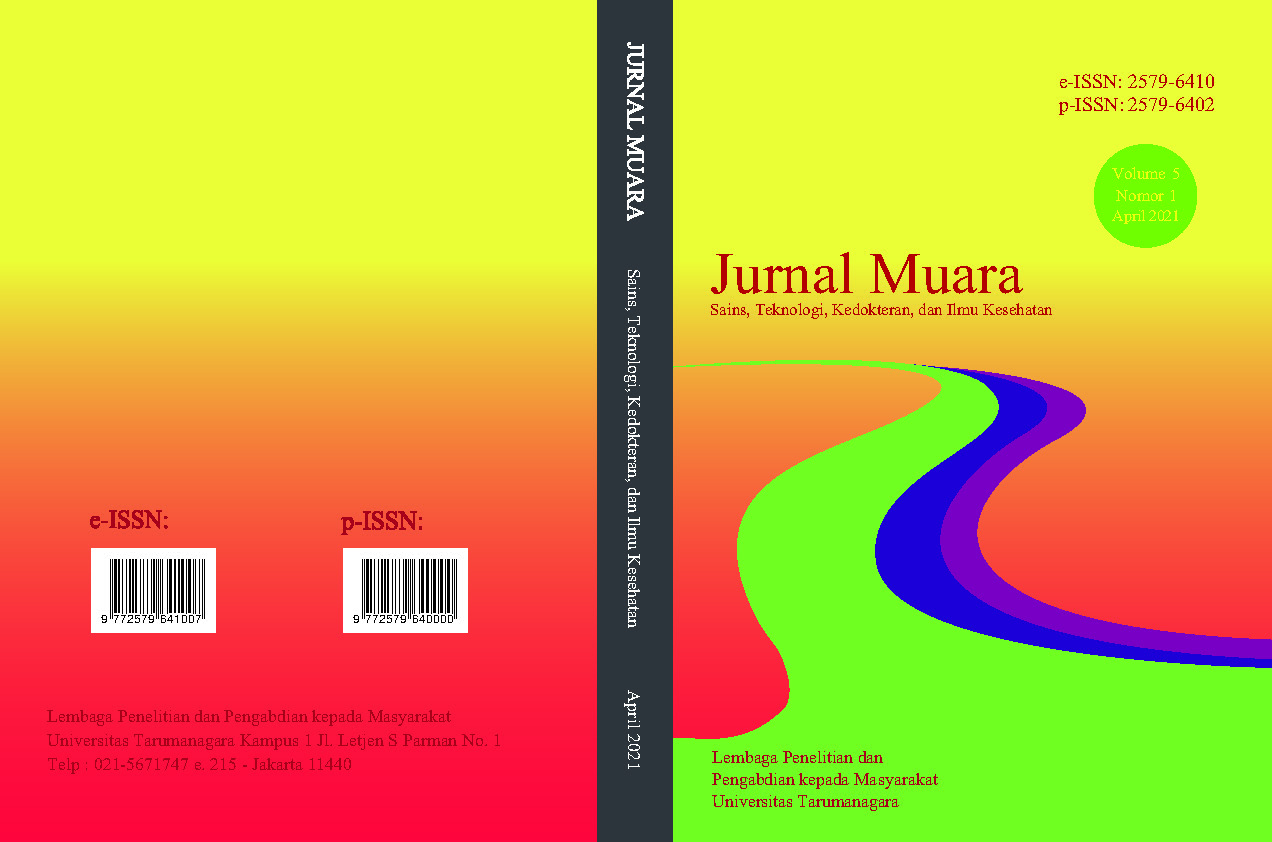HUBUNGAN USIA IBU BERSALIN, PARITAS DAN BERAT BAYI LAHIR DENGAN KEJADIAN PARTUS TAK MAJU
Main Article Content
Abstract
About 9% of maternal deaths are due to complications during pregnancy, childbirth and after delivery. The cause of maternal death was bleeding 30.1%, hypertension 26.9%, infection 5.6%, abortion 1.6%, prolonged labor 1.8% and others 34.5%. Data obtained at the Ade Mohammad Djoen Regional Hospital for the last 3 years has seen an increase in cases of prolonged labor. In 2017 there were 37 cases, in 2018 there were 39 cases, and in 2019 there were 48 cases. The purpose of this study was to determine the relationship between maternal age, parity and birth weight with the incidence of non-progressive labor. The research method is quantitative analytic with cross sectional design, using a retropective approach. The results of this study showed a relationship between maternal age and the incidence of prolonged labor with (p value = 0.008 (p <0.05) and an OR value of 2,250, which means that the age of mothers who gave birth who was <20 years or> 35 years had a risk of developing non-progressive labor 2,250. There is a relationship between parity and the incidence of underdeveloped labor (p value = 0.026 (p <0.05) with an OR value of 1.977, which means parity with the number of deliveries 1 or> 3 has a risk of developing non-progressive labor by 1.977 times. Between the birth weight and the incidence of non-progressive labor with (p value = 0.040 (p <0.05) with an OR value of 1.953, which means that the birth weight at risk >4000 grams has a 1.953 times greater risk of developing prolonged labor. This needs to increase service innovation in dealing with emergencies of underdeveloped labor, one of which is through early screening steps with antenatal care so that cases of prolonged labor can be prevented.
Keywords : birth weight; Prolonged labor; maternal age; parity
Abstrak
Sekitar 9% kematian maternal akibat komplikasi selama kehamilan, persalinan dan setelah persalinan. Penyebab kematian ibu perdarahan 30,1%, hipertensi 26,9%, infeksi 5,6%, abortus 1,6%, partus tak maju 1,8% dan lain-lain 34,5%. Data yang diperoleh di RSUD Ade Mohammad Djoen selama 3 tahun terakhir terjadi peningkatan kasus partus tak maju. Tahun 2017 ada 37 kasus, tahun 2018 ada 39 kasus, dan tahun 2019 menjadi 48 kasus. Tujuan penelitian ini mengetahui Hubungan Usia Ibu Bersalin, Paritas dan Berat Bayi Lahir dengan Kejadian Partus Tak Maju. Metode Penelitian adalah analitik kuantitatif dengan desain cross sectional, menggunakan pendekatan retropektif. Hasil penelitian ini ada hubungan usia ibu bersalin dengan kejadian partus tak maju dengan (p value = 0,008 (p < 0,05) dan nilai OR 2,250 yang berarti usia ibu bersalin yang <20 Tahun atau >35 tahun mempunyai resiko terjadinya partus tak maju 2,250 kali lebih besar. Ada hubungan paritas dengan kejadian partus tak maju dengan (p value = 0,026 (p < 0,05) dengan nilai OR 1,977 yang artinya paritas dengan jumlah persalinan 1 atau >3 mempunyai resiko terjadinya partus tak maju 1,977 kali. Ada hubungan antara berat bayi lahir dengan kejadian partus tak maju dengan (p value = 0,040 (p < 0,05) dengan nilai OR 1,953 yang artinya berat bayi lahir yang beresiko >4000 gram mempunyai resiko terjadinya partus tak maju 1,953 kali lebih besar. Saran dalam penelitian ini perlu meningkatkan inovasi pelayanan dalam menangani kegawatdaruratan partus tak maju salah satunya melalui langkah penapisan sejak awal dengan pemeriksaan kehamilan sehingga kasus partus tak maju dapat dicegah.
Article Details
Section
This work is licensed under a Jurnal Muara Sains, Teknologi, Kedokteran dan Ilmu Kesehatan Creative Commons Attribution-ShareAlike 4.0 International License.
Authors transfer copyright or assign exclusive rights to the publisher (including commercial rights)
References
Data Rekam Medis. (2020). RSUD Ade Muhammad Djoen Sintang.
Fatoni, A.A. (2011). Hubungan Usia Ibu, Paritas dan Berat Lahir terhadap Persalinan Macet di Rumah Sakit Adji Darmo Lebak. http://repository.uinjkt.ac.id/dspace/bitstream/123456789/25484/1/Agus%20Anang%20Fatoni%20-%20fkik%20.pdf
Fithri, H. (2011). Hubungan Paritas Dengan Lama Persalinan Kala II di Puskesmas Tengalrejo Yogyakarta Tahun 2011. http://digilib.unisayogya.ac.id/3781/1/NASKAH_HERMIA%20FITHRI%20LAILATUL%20HIDAYATI.pdf
Gultom, L. (2014). Faktor Yang Berhubungan Dengan Kejadian Partus Lama pada Ibu Bersalin di RSU Haji Medan Tahun 2014. http://ojs.poltekkes-medan.ac.id/pannmed/article/download/199/168
Kebijakan Pembangunan Kesehatan dan 5 Isu Strategis dalam Rapat Kerja Kesehatan Daerah Provinsi Kalimantan Barat Tahun 2019. https://dinkes.kalbarprov.go.id/wp-content/uploads/2019/03/KEBIJAKAN-PEMBANGUNAN-KESEHATAN-5-ISU-STRATEGIS.pdf
Kemenkes RI. (2014). Rakor Kemenkes RI. Jakarta : Dirjen BIAC GIZI KIA
Kementrian Kesehatan RI. (2015). Sensus Penduduk Kesehatan. Jakarta : Kementrian Kesehatan RI
Manuaba, IBG. (2010). Ilmu Kebidanan Penyakit Kandungan Dan KB. Jakarta: EGC
Notoatmodjo, S. (2010). Metodologi Penelitian Kesehatan. Cetakan Kelima. Jakarta: Rineka Cipta
Profil Kesehatan Provinsi Kalimantan Barat tahun 2018. https://www.kemkes.go.id/resources/download/profil/PROFIL_KES_PROVINSI_2018/20_Kalbar_2018.pdf
Purwaningsih & Fatmawati. (2010). Asuhan Keperawatan Maternitas. Yogyakarta: Nuha Medika
Puspita, E. (2014). Asuhan Kebidanan pada Persalinan Cetakan I. Jakarta: Trans Info Medika
Ruqaiyah. (2019). Faktor yang Berhubungan Terhadap Kejadian Partus Lama di Rumah Sakit AL Jala Ammari Makassar 2019. https://ojs.akbidpelamonia.ac.id/index.php/journal/article/view/135
SUPAS. (2015). https://sirusa.bps.go.id/sirusa/index.php/dasar/pdf?kd=2&th=2015
Varney, H., & Kribes, J. (2013). Buku Ajar Asuhan Kebidanan (1st and 2en ed). Jakarta: EGC
World Health Organization. (2014). Maternal Mortality. https://www.who.int/mediacentre/news/releases/2014/maternal-mortality/en/
World Health Organization. (2019). Maternal Mortality. https://www.who.int/news-room/fact-sheets/detail/maternal-mortality

